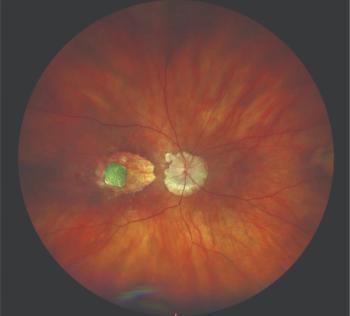
Genetic testing helps physicians zero in on ocular disease
Ann Arbor, MI-Scientists at the University of Michigan Kellogg Eye Center have developed a faster and more cost-effective method of genetic testing for autosomal recessive forms of retinitis pigmentosa (arRP). Using this microarray-based sequencing technology, researchers can look for disease-causing mutations on 11 genes at a time, according to Radha Ayyagari, PhD.
Ann Arbor, MI-Scientists at the University of Michigan Kellogg Eye Center have developed a faster and more cost-effective method of genetic testing for autosomal recessive forms of retinitis pigmentosa (arRP). Using this microarray-based sequencing technology, researchers can look for disease-causing mutations on 11 genes at a time, according to Radha Ayyagari, PhD.
Dr. Ayyagari, who is assistant professor, ophthalmology and visual sciences, University of Michigan, Ann Arbor, was lead author of a study on this new technology, published in the September 2005 issue of Investigative Ophthalmology & Visual Science (2005;46:3355-3362).
The arRP-I chip is the first successful application of this novel technology to screen for sequence alterations simultaneously in multiple genes on a single platform. To identify correctly the gene or gene interaction involved in RP, researchers previously would have to screen for each gene separately.
More efficient strategy
The search for a more efficient way to test whether any of the known genes carry mutations or whether there is a mutation in a new gene led to the design of the resequencing array. A selected sequence of genes was tiled onto a custom-designed 30-kb DNA sequencing platform. The arRP-I chip contains sequences or genetic codes for 11 genes that carry among them approximately 180 mutations associated with early-onset retinal degeneration.
Although more than 30 genes have been identified for various forms of RP, the size of the chip currently limits the ability to include them all in the array. The University of Michigan researchers designed the chip to include a selection of top-level genes that were most commonly implicated in RP and had the highest number of mutations, Dr. Ayyagari said. A recently discovered gene with a large number of mutations is one of several that the team plans to include in a larger platform that should be developed in another year or two.
Dr. Ayyagari's research team tested the array in a study involving 70 patients who had a clinical diagnosis of arRP. Thirty-five had not been previously screened, while the other 35 had known genetic mutations and were screened to validate the results. The chips produced 97.6% of the sequence analyzed with >99% accuracy and reproducibility.
Knowing the mutation responsible for an individual's disease has several benefits, including tailored therapy and improved patient counseling, Dr. Ayyagari said.
Genetic counseling
Most patients have the simplex form, meaning that they have no known family history of RP. Many of these individuals have either X-linked or autosomal recessive RP, both of which could have significant implications for their family members.
"If we can find the mutations in the RP genes, we can distinguish the form of RP and tell the risk of others in the family having X-linked RP or recessive RP," she added.
Since the risk of having a child affected by RP depends on the genetic makeup of each parent and the form of disease, having more specific information enables genetic counselors to provide better advice to patients.
Being able to pinpoint the responsible genetic mutation can also enhance treatment. Several groups of researchers are actively working on treatments for RP, some of which are specific to certain genes, Dr. Ayyagari said.
"Once you know which gene is involved in causing the disease, then it is easy to determine which type of treatment is suitable for that particular disease," she explained.
While treatments are not yet available for many forms of RP, gene identification must continue to advance toward that eventuality, Dr. Ayyagari added.
"Before the treatments become available, we need to be ready with the technology to genotype patients and detect what kind of mutations they have," Dr. Ayyagari said. "It would be a major setback if the treatments were available but we could not identify the patients."
Newsletter
Don’t miss out—get Ophthalmology Times updates on the latest clinical advancements and expert interviews, straight to your inbox.





